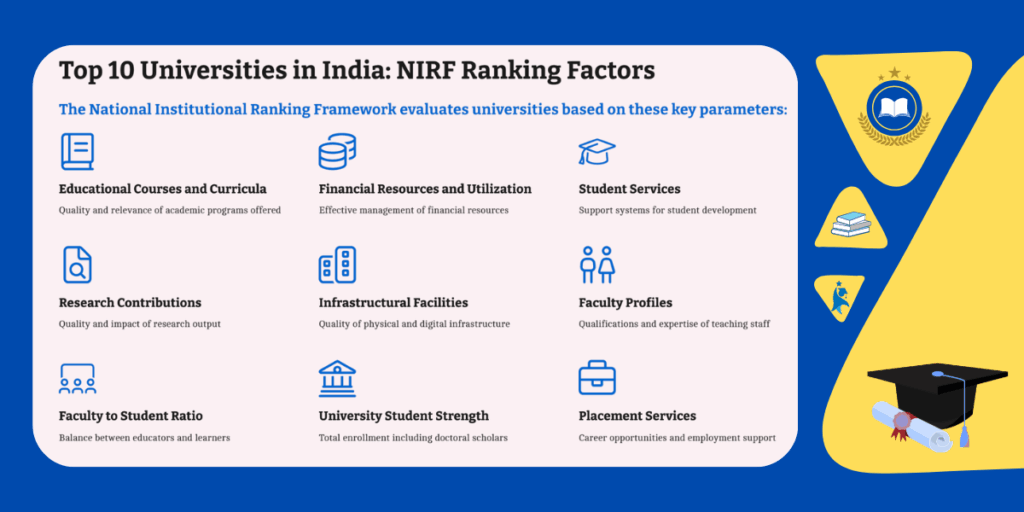

Quick Summary
NIRF stands for National Institutional Ranking Framework.
Distance education is where students and instructors are physically separated and instruction is delivered online.
Top 3 universities according to NIRF are: Indian Institute of Science, Jawaharlal Nehru University and Jamia Millia Islamia.
Choosing the right university is a pivotal decision that can significantly influence a student’s academic and professional future. Our pick of the top 10 Universities in India represents the pinnacle of higher education, offering unmatched opportunities for learning, research, and career advancement. These institutions are renowned for their rigorous academic standards, distinguished faculty, and cutting-edge facilities, which collectively foster an environment conducive to intellectual growth and innovation.

Choosing a top university boosts your chances for top internships, strong industry exposure, and better career prospects through quality education and alumni support. A top university not only builds knowledge but also boosts confidence and personal growth, making it a smart step toward a strong and rewarding career.
Read our comprehensive guide to determine which of our list of top 10 Universities in India is the best for your goals. For the best global universities in India, read more here.
While the NIRF rankings assess universities within India, many Indian institutions are also recognized globally. For example:
Read more: How To Prepare For Personal Interview?

After a comprehensive evaluation of these parameters, NIRF assigns a score to each university, creating a list of the top 10 out of over 1000 universities in the country.
The National Institutional Ranking Framework (NIRF) is an initiative by the Government of India to rank higher education institutions in the country. The rankings are based on parameters that evaluate various aspects of an institution’s performance. The NIRF ranking process involves the following key steps:
1. Teaching, Learning & Resources (TLR): This considers aspects like student strength, faculty-student ratio, faculty qualifications and experience, infrastructure, and learning resources.
2. Research and Professional Practice (RP): This evaluates research publications, patents, consultancy projects, sponsored research, and professional collaborations.
3. Graduation Outcomes (GO): This looks at student placement rates, median salary packages, higher studies pursued by graduates, and entrepreneurship ventures.
4. Outreach and Inclusivity (OI): This assesses the institution’s efforts towards inclusivity for students from diverse backgrounds, scholarships, student support services, and contributions to the community.
5. Perception (PR): This considers the reputation of the institution among peers (faculty and students) and employers.
It’s important to note that NIRF rankings aim to provide a comprehensive view of an institution’s performance, considering both quantitative and qualitative aspects. The rankings are updated annually, and the process is designed to be transparent and fair.
Read more: 7 Life-Changing Tips To Know How To Achieve Success In Life
There are three types of education provided in the top 10 universities:
The part-time or evening program is directed at working professionals, students, and individuals for whom full-time education is not an option. These programs provide learners with the opportunity to study and earn degrees, diplomas, or certificates while working or maintaining other commitments.
Distance education and online learning allow students to earn their academic degrees, diplomas, and certificates without being present in a physical classroom. Such programs may either be self-paced or scheduled, where education is delivered remotely using electronic platforms, video lectures, or study materials.
Blended Learning is an innovative educational paradigm of mixing traditional face-to-face classroom learning with online/digital learning means. It includes the benefits of face-to-face interaction along with the flexibility of online learning, creating an interesting and effective experience. This definition shall not satisfactorily capture the actual essence of a blended learning system.

NIRF released University rankings on 12th August 2024. A list of the top 10 universities in India based on the NIRF 2024 ranking is given below, along with their states and positions.
Here are the National Institutional Ranking Framework (NIRF) rankings for the specified universities over the past three years:
| University Name | 2024 Rank | 2023 Rank | 2022 Rank |
|---|---|---|---|
| Indian Institute of Science (IISc), Bengaluru | 1 | 1 | 1 |
| Jawaharlal Nehru University (JNU), New Delhi | 2 | 2 | 2 |
| Jamia Millia Islamia (JMI), New Delhi | 3 | 3 | 3 |
| Jadavpur University, Kolkata | 4 | 4 | 4 |
| Banaras Hindu University (BHU), Varanasi | 5 | 5 | 5 |
| Manipal Academy of Higher Education, Manipal | 6 | 6 | 6 |
| Amrita Vishwa Vidyapeetham, Coimbatore | 7 | 7 | 7 |
| Vellore Institute of Technology (VIT), Vellore | 8 | 8 | 8 |
| Aligarh Muslim University (AMU), Aligarh | 9 | 9 | 9 |
| University of Hyderabad, Hyderabad | 10 | 10 | 10 |
These rankings are consistent across the years 2022 to 2024, reflecting the sustained academic excellence and research contributions of these institutions. For more detailed information, refer to the official NIRF website.

1. Quality Education and Rigorous Curriculum:
2. Enhanced Career Prospects and Placements:
3. Networking Opportunities:
4. Holistic Development and Exposure:

Read below to decide from our selection of the top 10 universities in India in detail. Understand their courses, fees, entrance exams, and campus life details below.
| University Name | NIRF Rank 2024 | Global QS Rank 2025 | Top Courses | Average Fees (INR) | Admission Through |
|---|---|---|---|---|---|
| Indian Institute of Science (IISc) | 1 | 155 | Science, Engineering | 20,000–40,000 | JEE Advanced/GATE |
| Jawaharlal Nehru University (JNU) | 2 | 601–650 | Humanities, Social Sciences | 10,000–12,000/year | CUET/University Test |
| Jamia Millia Islamia (JMI) | 3 | 951–1000 | Mass Comm, Law, Social Sciences | 8,000–35,000/year | CUET/JMI Entrance Exam |
| Jadavpur University | 4 | NA | Engineering, Arts, Science | 2,500–10,000/year | WBJEE/University Test |
| Banaras Hindu University (BHU) | 5 | 601–650 | Ayurveda, Arts, Law | 12,000–30,000/year | CUET/University Test |
| Manipal Academy of Higher Education | 6 | 751–760 | Medicine, Engineering, Management | 2–4 Lakhs/year | MET (Manipal Entrance Test) |
| Amrita Vishwa Vidyapeetham | 7 | 801–850 | Engineering, Medical, Business | 2–3 Lakhs/year | AEEE/NEET/University Test |
| Vellore Institute of Technology (VIT) | 8 | 851–900 | Engineering, IT, Design | 1.6–2.5 Lakhs/year | VITEEE |
| Aligarh Muslim University (AMU) | 9 | 1001–1200 | Law, Arts, Engineering | 10,000–30,000/year | CUET/AMU Entrance Test |
| University of Hyderabad | 10 | 751–800 | Life Sciences, Social Sciences | 5,000–20,000/year | CUET/University Test |
The number 2 university in India is the Indian Institute of Science (IIS), based in Karnataka. IIS is a public college that holds the second rank in NIRF 2024.
Jawaharlal Nehru University, or JNU, is spread across an area of 1020 acres in New Delhi. It is systematically distributed into 12 Schools, 55 centers, 6 Special centers, Language and Science labs, an art library, seminar rooms, and advanced auditoriums.
Jamia Millia Islamia is in the top 15 universities in India. It was established in 1920. It is a central university located in Delhi. JMI was accredited with an A grade by the National Assessment and Accreditation Council (NAAC).
Jadavpur University is located in West Bengal. It has two campuses: 58 acres in Jadavpur and 26 acres near Salt Lake. It was accredited an A grade by NAAC with a CGPA of 3.68.
BHU is an internationally recognized university based in Uttar Pradesh. It is one of the leading universities in India and is well-known for its research-related courses. It has 6 centres of advanced studies, 10 departments under the Special Assistance Programme, and a large number of specialised research centres. The main campus is spread over 1300 acres and is the largest residential university in India.
The next university in our list of the top 10 Universities in India is Manipal Academy of Higher Education. It is more commonly known as Manipal University and is located in Karnataka. It has campuses in Mangalore and Bangalore, with off-campus locations in Dubai and Malaysia. The main campus size is 844 acres.
One of the top 10 universities in India is Amrita Vishwa Vidyapeetham, located in Tamil Nadu. Among our list of top 10 universities in India, NIRF ranks it in the top 15. The campuses of the university are located in Amritapuri, Amaravati, Bengaluru, Chennai, Coimbatore, Kochi, and Mysore.
The University Grants Commission Act (UGC) founded the Vellore Institute of Technology (VIT) in 1984. VIT is located in Tamil Nadu. It currently stands in 8th place among the top 10 universities in India. High placements and packages put it in front of other universities.
Sir Syed Ahmad Khan established Aligarh Muslim University as the Muhammadan Anglo-Oriental College in Aligarh, Uttar Pradesh, India, in 1875. NIRF ranks it at the 19th position among our list of the top 10 universities in India.
One of the most prominent universities on our list of the top 10 Universities in India is the University of Hyderabad. It is based in Telangana. The university is known for its postgraduate and research courses.
Top 10 Universities in India: India boasts some of the premier universities in the world, an institution that offers the best education, leading-edge research, and exemplary career choices. The top 10 universities in India greatly emphasise academic excellence, world-class faculty, and infrastructure developments. It is therefore preferred among students nationally. These universities form the very essence of governance in the IITs, management in the IIMs, or other great institutions of research catering to the fate of millions in the future. Choosing the right university stands very critical for personal and professional growth, and these institutions enable one for that very platform to stand ahead in any competitive world.
Use our guide of the Top 10 Universities in India to evaluate numerous career choices and choose the right career path for yourself. Dive into our guide on Career Advice.

We can rely on NIRF rankings to determine the best university. All the universities we have mentioned in our list are among the best, but as per the ranking, the Indian Institute of Technology Madras is the best one in India.
The top 10 universities in India, according to NIRF ranking, are as follows:
1. Indian Institute of Science (IISc), Karnataka
2. Jawaharlal Nehru University (JNU), Delhi
3. Banaras Hindu University (BHU), Uttar Pradesh
4. Jamia Millia Islamia, Delhi
5. Jadavpur University, West Bengal
6. Amrita Vishwa Vidyapeetham, Tamil Nadu
7. Manipal Academy of Higher Education, Karnataka
8. Vellore Institute of Technology (VIT), Tamil Nadu
9. Aligarh Muslim University (AMU), Uttar Pradesh
10. University of Hyderabad, Telangana
The Top 3 universities are as follows:
Indian Institute of Science (IISc), Karnataka
Jawaharlal Nehru University (JNU), Delhi
Banaras Hindu University (BHU), Uttar Pradesh
Recent trends indicate that Computer Science is emerging as a popular choice among B. Tech students. Similarly, Economics and Psychology are gaining traction in the Arts and Humanities disciplines. To identify the course that best suits your interests, it is advisable to examine the syllabus and explore the potential career opportunities within each field.
You can apply to these universities by going to their official website and filling out the application form for the preferred courses. Most courses and colleges require you to take an entrance exam along with the application form.
According to the Indian Institutional Ranking Framework of engineering colleges for the year 2021, the top universities in India ranks are taken by the IITs and under the private colleges’ category, The Birla Institute of Technology and Science, Pilani ranks first.
The top 10 National Law Universities (NLUs) in India, based on various rankings and reputation, include: NLSIU Bangalore, NLU Delhi, NALSAR Hyderabad, NUJS Kolkata, NLU Bhopal, NLU Jodhpur, GNLU Gandhinagar, RGNUL Patiala, RMLNLU Lucknow, and NLUO Cuttack
The top 10 government agricultural universities in India, based on various rankings and recognitions, include: ICAR-Indian Agricultural Research Institute (New Delhi), Punjab Agricultural University (Ludhiana), ICAR-National Dairy Research Institute (Karnal), G.B. Pant University of Agriculture & Technology (Pantnagar), Tamil Nadu Agricultural University (Coimbatore), University of Agricultural Sciences (Bangalore), Chaudhary Charan Singh Haryana Agricultural University (Hisar), ICAR-Indian Veterinary Research Institute (Izatnagar), Sher-e-Kashmir University of Agricultural Sciences and Technology (Srinagar), and Acharya N.G. Ranga Agricultural University (Guntur).
The top 10 central universities in India, as per various rankings and surveys, include Jawaharlal Nehru University (JNU), University of Delhi (DU), Banaras Hindu University (BHU), Jamia Millia Islamia (JMI), Aligarh Muslim University (AMU), University of Hyderabad, Tezpur University, Central University of Punjab, Visva Bharati University, Pondicherry University.
The Indian Institutes of Technology (IITs) are consistently ranked among the top universities in India. Specifically, IIT Madras, IIT Delhi, and IIT Bombay are frequently cited among the best. Additionally, the Indian Institute of Science (IISc) in Bangalore, and Jawaharlal Nehru University (JNU) in Delhi are also highly regarded.
The best college in India depends on individual priorities and academic interests, but some consistently rank high. The Indian Institute of Science (IISc) Bangalore is often cited as the best overall university

Authored by, Gagandeep Khokhar
Career Guidance Expert
Gagandeep is a content writer and strategist focused on creating high-performing, SEO-driven content that bridges the gap between learners and institutions. He crafts compelling narratives across blogs, landing pages, and email campaigns to drive engagement and build trust.
Editor's Recommendations
Chegg India does not ask for money to offer any opportunity with the company. We request you to be vigilant before sharing your personal and financial information with any third party. Beware of fraudulent activities claiming affiliation with our company and promising monetary rewards or benefits. Chegg India shall not be responsible for any losses resulting from such activities.
Chegg India does not ask for money to offer any opportunity with the company. We request you to be vigilant before sharing your personal and financial information with any third party. Beware of fraudulent activities claiming affiliation with our company and promising monetary rewards or benefits. Chegg India shall not be responsible for any losses resulting from such activities.